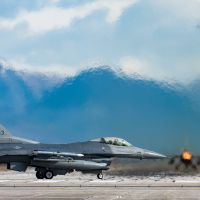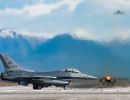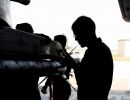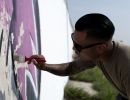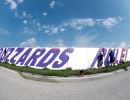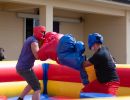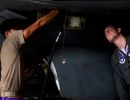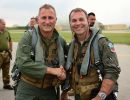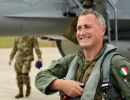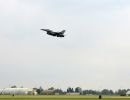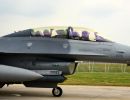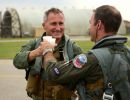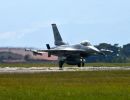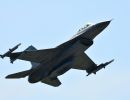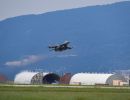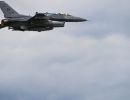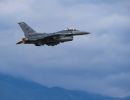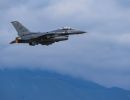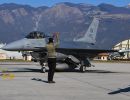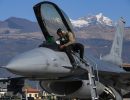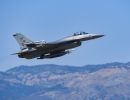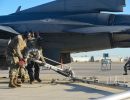Night Vision Goggles
Hehs, Eric. Code One: Jan 1998. Vol. 13 No. 1: Pg 10-15.
 "I truly believe the Block 40 Vipers sitting on the ramp here are the most combat capable fighters ever fielded," says Lt. Col. David Nichols, the commander of the 510th ( photo below, right .) "We fly some unique missions from Aviano. We regularly perform Deliberate Guard missions over Bosnia with live weapons, including precision-guided munitions, air-to-air missiles, and rockets."
"I truly believe the Block 40 Vipers sitting on the ramp here are the most combat capable fighters ever fielded," says Lt. Col. David Nichols, the commander of the 510th ( photo below, right .) "We fly some unique missions from Aviano. We regularly perform Deliberate Guard missions over Bosnia with live weapons, including precision-guided munitions, air-to-air missiles, and rockets."
 Those Deliberate Guard missions go a long way in explaining the level of capability found in Aviano's F-16s.
Those Deliberate Guard missions go a long way in explaining the level of capability found in Aviano's F-16s.
"I don't think our flights over Bosnia are going to stop any time soon," Nichols admits. "They are a strain, but we are proud of what we are accomplishing over there. Air presence is required to enforce sanctions and to return the region to stability. We use air power and jet noise, the threat of what these airplanes can do, to further a peace process. When pilots come back from a Deliberate Guard mission, they can tell the weapon loaders and the maintainers that what we are doing over Bosnia is making a difference. We may not be dropping or shooting anything right now, but the fact that armed F-16s are flying overhead enhances the ability of peacekeeping forces on the ground."
The F-16 missions over the former Yugoslavia have evolved from Deny Flight missions that enforced a no-fly zone to the highly successful precision bombing campaign of Deliberate Force to the current ground support missions of Deliberate Guard.
These days, Nichols and his fellow F-16 pilots at Aviano fly a variety of close air support missions over Bosnia, exercising what has become a highly refined CAS network. The network includes satellite reconnaissance, airborne warning and control, and ground based tactical air control parties. The latter, called TACPs (pronounced TACK peas), are assigned to Army ground units and consist of one air control officer and three to four enlisted controllers, often from a variety of countries. They operate with four primary pieces of equipment: a laser targeting system, a global positioning system, a laptop computer, and a radio.
"We communicate with TACPs on the ground from the cockpit," Nichols explains. "They guide us onto real targets, using the improved data modem that is part of our Sure Strike system. Though we don't drop bombs, practice or real, those on the ground in Bosnia know we can take care of a target or deliver munitions at any time, on short notice, at day or at night. Our capability is tremendous. We have developed a CAS request network, and our TACP and aircrew proficiency is very high.
"All operations flown over the former Yugoslavia benefit from an advanced intelligence system that provides outstanding support," Nichols adds. "The addition of Gold Strike to our jets will further enhance the overall capability of the entire system as well as our own capabilities to support the mission." Gold Strike is a system that allows F-16 pilots to share images between ground and aerial assets. Nichols expects it to be especially beneficial in dynamic situations in which pilots are re-tasked after they take off.
 The NVIS modification improves the overall effectiveness of flying at night with NVGs. Part of the modification addresses cockpit lighting. NVGs, which amplify light in the visible and near infrared part of the frequency spectrum, don't get along well with the standard "white" light in the cockpit. Without cockpit lighting compatible with NVGs, pilots have to modify the cockpit themselves before every night mission.
The NVIS modification improves the overall effectiveness of flying at night with NVGs. Part of the modification addresses cockpit lighting. NVGs, which amplify light in the visible and near infrared part of the frequency spectrum, don't get along well with the standard "white" light in the cockpit. Without cockpit lighting compatible with NVGs, pilots have to modify the cockpit themselves before every night mission.
The NVIS modification at Aviano is being installed by a team of Lockheed Martin employees and USAF maintenance personnel from the 510th and 555th ( photo to the right. ) "The team doing the mod is outstanding," says Nichols. "They are truly great Americans. They love what they are doing, and they are proud that they are playing an important role in strengthening our capabilities. They are working hard to make it work. We have had almost no problems with the modification."
 Nichols and other F-16 pilots at Aviano are enjoying the transition from a makeshift system of Velcro, green filters, and lightsticks to an integrated lighting system customized for flying at night. "Without the NVIS cockpit mod, we have to turn down the normal cockpit lighting and place ten lightsticks around the cockpit to illuminate the instruments," Nichols explains. "The lightsticks are inserted into plastic windowed cylinders that can be attached to cockpit surfaces with Velcro fasteners. A pilot has to remove the container and a lightstick from a carrying case, break a lightstick, shake it, take the top off the container, put the lightstick in the container, screw the top on, then attach the container to one of ten designated areas in the cockpit ( Photo to the left .)
Nichols and other F-16 pilots at Aviano are enjoying the transition from a makeshift system of Velcro, green filters, and lightsticks to an integrated lighting system customized for flying at night. "Without the NVIS cockpit mod, we have to turn down the normal cockpit lighting and place ten lightsticks around the cockpit to illuminate the instruments," Nichols explains. "The lightsticks are inserted into plastic windowed cylinders that can be attached to cockpit surfaces with Velcro fasteners. A pilot has to remove the container and a lightstick from a carrying case, break a lightstick, shake it, take the top off the container, put the lightstick in the container, screw the top on, then attach the container to one of ten designated areas in the cockpit ( Photo to the left .)
"After about two hours into the flight," Nichols continues, "the lightsticks go dim. So we go through the process of replacing them one at a time, which is considerably more difficult to do while flying. Before we take off, we have to cover all other light sources with green filters or black tape, except the multifunction displays. The preparation takes about ten minutes. We need another ten minutes after landing to restore the airplane and to make sure no foreign objects are left in the cockpit. Pilots are elated when they don't have to go through that process. All the hassle is eliminated with the NVIS mod. That extra half hour has been replaced by a flick of a switch. And the lighting itself is much improved."
 "I thought the glowsticks did a fine job until I saw the NVIS cockpit lighting," adds Capt. Scott Gierat ( photo to the right .) "The syst em is much easier to use and the lighting itself is so much better. NVIS cockpit lighting is fantastic even without goggles. We don't get the glow across the canopy that we see with standard lighting. The lighting is also more relaxing to the eye. The NVIS cockpit is a tremendous improvement."
"I thought the glowsticks did a fine job until I saw the NVIS cockpit lighting," adds Capt. Scott Gierat ( photo to the right .) "The syst em is much easier to use and the lighting itself is so much better. NVIS cockpit lighting is fantastic even without goggles. We don't get the glow across the canopy that we see with standard lighting. The lighting is also more relaxing to the eye. The NVIS cockpit is a tremendous improvement."
Aviano F-16 pilots are equally pleased with the exterior lighting portion of the NVIS modification as well. "The exterior lighting is spectacular," Nichols says. "In covert mode, the airplane is completely dark to the naked eye. And the variable covert strobe allows us to discern different airplanes by the rate at which the strobe flashes. We can look around in a four-ship and know where everybody is."
Nichols says the variable strobe is especially helpful in the forward air controller or FAC mission. "NVGs make it difficult to perceive range," he explains. "A bright object ten miles away may appear closer than a nearby dim object. Depth perception works differently at low light levels. A unique strobe rate makes it real simple to distinguish a wingman from other light sources."
The NVG-friendly lighting also improves the air-to-air capabilities of F-16s at night. "We can easily distinguish our aircraft from aircraft with norm lighting," Nichols explains. "When we fly against a airplane without NVG-compatible lighting, we can sort other aircraft visually from a long way out, sometime before we can sort them on the radar."
The NVIS modification adds another tool to a highly developed night capability at Aviano. Both F-16 squadrons have been flying with NVGs since August 1996. They have been flying with LANTIRN pods for longer than that. "NVIS increases the overall safety of the airplane, and external lighting improves our ability to fly with near daytime tactics," Nichols says. "But the LANTIRN system is still the key to our night missions."
LANTIRN and NVGs operate in different energy bands. The goggles detect energy in the visible and near infrared bands; the targeting pod functions well within the infrared. "When combined," says Nichols, "the capability is spectacular. Both systems are effective with the infrared rockets we can fire from our LAU-131 rocket pods." The infrared marker rockets, used by A-10s in the FAC role for several years, put out infrared energy instead of light. They can mark an area on the ground covertly.
"Night FACing is almost easier than day FACing if the controller on the ground has laser equipment," Nichols explains. "The goggles help us find a target if the guy on the ground has laser devices or an infrared light source." NVGs also enhance Sure Strike capability because pilots can use them to validate coordinates for targets that they would not be able to see at night or have difficulty finding with LANTIRN alone. The NVIS covert lighting makes the F-16s invisible (optically) to potential ground threats.
 "Basically, NVGs allow us to fly dayish tactics at night," adds Gierat. "Say we need to drop two laserguided bombs on two ground targets that are close together. With goggles, we can fly as a two-ship and normal release the bombs at the same time. With LANTIRN only, the second aircraft has to fly about eight miles back to clear the bomb blast and to allow the dust sometimes cloud to settle so the second target can be lased." Nichols expects the NVIS modification will allow the F-16 squadrons at Aviano to qualify more pilots to fly at night. "The light sticks required us to select only the more experienced pilots for this training," he explains. "We need a certain comfort level in the F-16 to deal with the burden of lightsticks and goggles. The NVIS lighting will allow us to check out less-experienced pilots to fly with the goggles. Originally, we wanted half of our pilots to be night qualified. Now we are looking at having the entire squadron qualified once all of our jets are modified."
"Basically, NVGs allow us to fly dayish tactics at night," adds Gierat. "Say we need to drop two laserguided bombs on two ground targets that are close together. With goggles, we can fly as a two-ship and normal release the bombs at the same time. With LANTIRN only, the second aircraft has to fly about eight miles back to clear the bomb blast and to allow the dust sometimes cloud to settle so the second target can be lased." Nichols expects the NVIS modification will allow the F-16 squadrons at Aviano to qualify more pilots to fly at night. "The light sticks required us to select only the more experienced pilots for this training," he explains. "We need a certain comfort level in the F-16 to deal with the burden of lightsticks and goggles. The NVIS lighting will allow us to check out less-experienced pilots to fly with the goggles. Originally, we wanted half of our pilots to be night qualified. Now we are looking at having the entire squadron qualified once all of our jets are modified."
 Currently, five training sorties are required to become qualified to fly as a two-ship wingman. Every sortie has to occur within a two-week period. Two more flights are necessary to become a flight lead. Two additional flights are needed to be an instructor pilot for a two-ship.
Currently, five training sorties are required to become qualified to fly as a two-ship wingman. Every sortie has to occur within a two-week period. Two more flights are necessary to become a flight lead. Two additional flights are needed to be an instructor pilot for a two-ship.
"We qualify most of our NVG pilots to the two-ship wingman level," Nichols says. "If a pilot is already an instructor pilot, we give him the two extra rides to qualify as an NVG instructor. If he is already a flight lead, he will receive two more flights to be an NVG flight lead." Both F-16 squadrons at Aviano are gearing up to fly four-ship tactics with NVGs, which will add two or three more rides to the training syllabus. "It takes practice to get used to the goggles," Nichols continues. "The expectation is always high when a pilot first puts on the goggles. His natural human reaction is not to move his head enough the first time he flies with them. I use an owl analogy. An owl's eyes are fixed in its head, but its head can swivel 180 degrees. When flying with goggles, a pilot has to move his head from side to side like an owl. By the second ride, pilots come back complaining of sore necks. That means that they're doing something right. Once pilots get physiologically adapted to them, their attitude changes. They will not fly at night without NVGs."
As NVGs become more essential for flying at night, the benefits of the NVIS modification will become more apparent as well. "Goggles and NVIS should go together," Nichols says. "The lighting modification increases safety and capability at the same time."
"For the cost of the goggles and the modification," adds Gierat, "the capability is well worth the money. The goggles are getting better. We can get a visual acuity of 20/25 with them. If we are going to be out there at night, this is the way to go."
From the April 1998 Letters
Thanks From Aviano
The recent Code One article "Night Vision at Aviano" is outstanding. The entire USAF is in the dark and needs to get NVGs and modify their jets with the night vision imaging system. Articles like this that focus on the success of the modification and the resulting awesome enhancements in capabilities help move the Air Force in the right direction.
Code One is a great asset to all of us who use the F-16 to make a living. We truly appreciate anything that helps us tell our story and enhance our capabilities.
Great work!
David C. Nichols, Commander
510th Fighter Squadron
Aviano AB, Italy

 If USAF has such a thing as a food chain, F-16s at Aviano are dining near the top. The Block 40 jets at this air base in northern Italy are fully outfitted with LANTIRN navigation and targeting pods. They are the first and only operational F-16s with Sure Strike—a system that receives highly accurate targeting information from the ground. They are also the first F-16s in the active-duty Air Force to employ night vision goggles, or NVGs, operationally. And by march, all of the F-16s of Aviano’s 510th and 555th Fighter Squadrons will have cockpits and external lighting that are fully compatible with NVGs, thanks to a modification called the night vision imaging systems, or NVIS.
If USAF has such a thing as a food chain, F-16s at Aviano are dining near the top. The Block 40 jets at this air base in northern Italy are fully outfitted with LANTIRN navigation and targeting pods. They are the first and only operational F-16s with Sure Strike—a system that receives highly accurate targeting information from the ground. They are also the first F-16s in the active-duty Air Force to employ night vision goggles, or NVGs, operationally. And by march, all of the F-16s of Aviano’s 510th and 555th Fighter Squadrons will have cockpits and external lighting that are fully compatible with NVGs, thanks to a modification called the night vision imaging systems, or NVIS.
